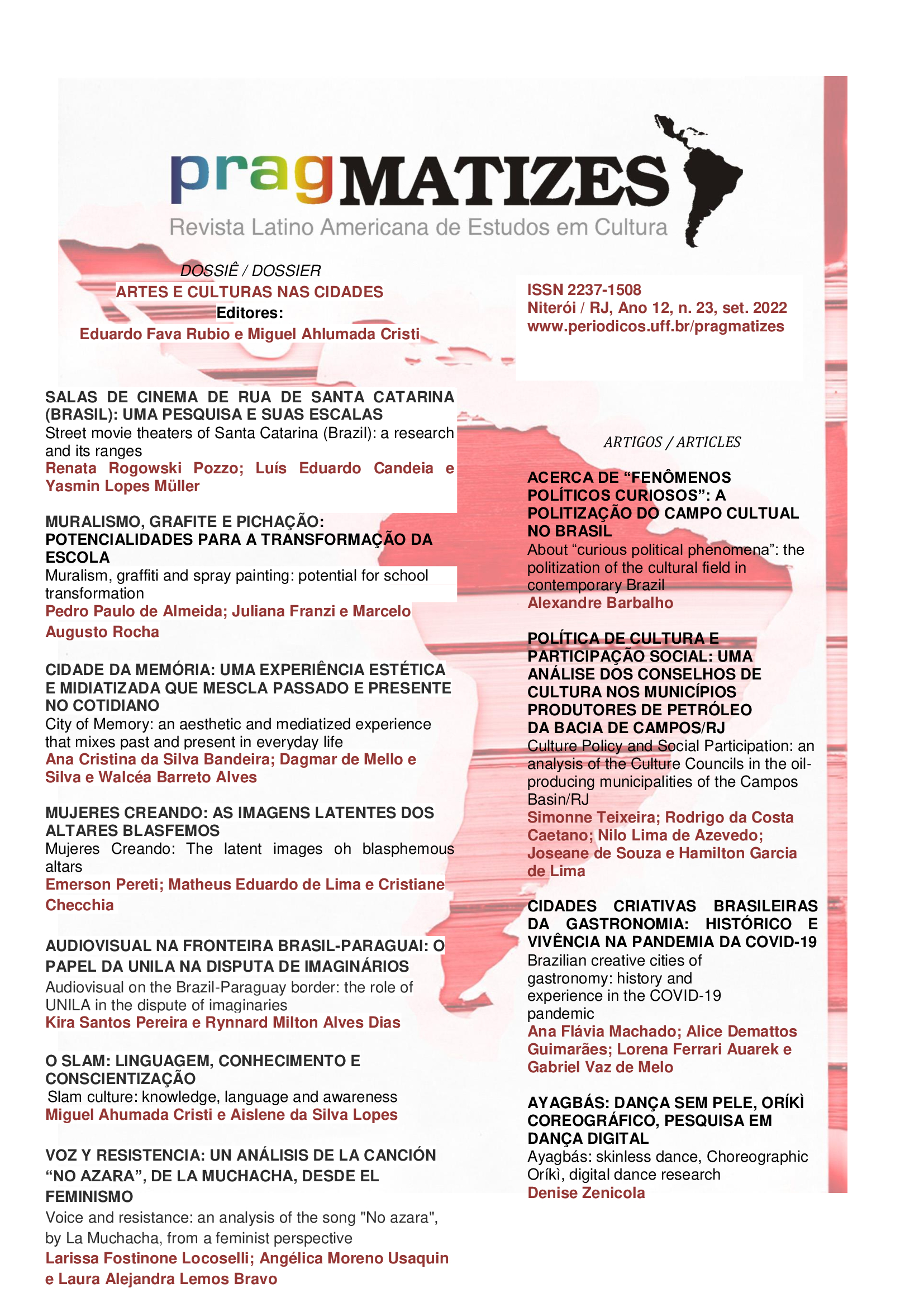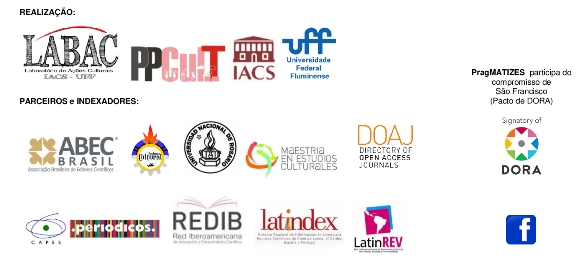Mujeres Creando
the latent images oh blasphemous altars
DOI:
https://doi.org/10.22409/pragmatizes.v12i23.53397Keywords:
Mujeres Creando, blasphemy, artistic dissidenceAbstract
This study addresses three artistic interventions by the Bolivian social movement Mujeres Creando, installed in biennials and art shows held in La Paz, Quito and Santiago de Chile between the years 2016 and 2018. Called "Altares Blasfemos", these installations consisted of a blunt critique of the State-Catholic Church dyad that sustains patriarchy and historical violence against women in Latin America. Through the caricaturish reproduction of images from the Christian imaginary and the recreation of subversive figures from Catholic iconography, the artists proposed a kind of unbearable image, that is, an artistic expression that intends to be as grotesque as the historical experience it aims to represent. Given the deep theological-colonial structures still ingrained in Latin American mentalities and institutions, such sacrilege obviously generated different types of reaction - from the literal attempt to exprobate and erase the work to different forms of legal-bureaucratic censorship. Based on works by Didi-Huberman, Jacques Rancière, Aline Miklos, among others, the study seeks to raise questions about the particularities of this type of artistic intervention and its reverberations in a project of radical dissensus with the conformations of colonial-capitalist power still in force in Latin America.
Downloads
References
AGAMBEN, Giorgio. O que é contemporâneo? e outros ensaios. Trad. Vinícius Nicastro Honesko. Chapecó: Argos, 2009.
ANTELO, Raul. Potência da imagem. Chapecó: Argos, 2004.
BUCK-MORSS, Susan. O presente do passado. Trad. Ana Luiza Andrade e Adriana Varandas. Desterro [Florianópolis]: Cultura e Barbárie, 2018.
DELEUZE, Gilles; GUATTARI, Félix. Kafka: por uma literatura menor. Trad. Cíntia Vieira da Silva. Belo Horizonte: Autêntica, 2017.
DIDI-HUBERMAN, Georges. Diante da Imagem: questão colocada aos fins de uma história da arte. Trad. Paulo Neves. São Paulo: Editora 34, 2013.
DIDI-HUBERMAN, Georges. O que vemos, o que nos olha. Trad. Paulo Neves. 2ª ed. São Paulo: Editora 34, 2010.
FOUCAULT, Michael. O Corpo Utópico, As Heterotopias. Trad. Salma Tannus Muchail. São Paulo: n-1 Edições, 2013.
GARAMUÑO, Florencia. Frutos estranhos: sobre a especificidade na estéticas contemporânea. 1. ed. 2014: Rocco, 2014.
MIKLOS, Aline. Mitoforias Contemporâneas: a reinvenção da Virgem por coletivos de artistas feministas. 12. ed. Porto Alegre: Revista Valise, 2016. p. 79-96.
MIKLOS, Aline. Quando a arte pode blasfemar. 1. ed. Buenos Aires: Instituto de Investigaciones Gino Germani, 2011.
PALLOTTA, Julien. A trajetória teórico-política de Jacques Rancière. 12. ed. [S.l.]: Revista Aisthe, 2014. p. 52-68.
PARALAJE. La intimidad es política: hay más mujeres (y hombres) creando…. Disponível em: http://www.paralaje.xyz/la-intimidad-es-politica-hay-mas-mujeres-y-hombres-creando/. Acesso em: 22 set. 2021.
PARALAJE. ¿Provocar a quién?. Disponível em: http://www.paralaje.xyz/de-intimidades-mas-que-politicas/. Acesso em: 22 set. 2021.
PERETI, Emerson. De desaparecidos e reaparecidos: as políticas da morte, o impulso da vida e a latência das artes. In: GUIZZO, Antonio Rediver; PERETI, Emerson; MATIAS, Felipe dos Santos (orgs.) América Latina: estudos comparados em literaturas e outras artes. São Carlos: Pedro & João Editores, 2020.
PRADO, Daniela Berger. Prácticas incómodas en el la Solidaridad Salvador Allende: tres traidoras a la patria. 14. ed. [S.l.]: Revista Caiana, 2018. p. 164-176.
RANCIÈRE, Jacques. A Estética como Política. 7. ed. Belo Horizonte: Devires, 2010. p. 14-36.
WEINRICH, Harald. Lete: arte e crítica do esquecimento. Tradução de Lya Luft. Rio de Janeiro: Civilização Brasileira, 2001.
Published
How to Cite
Issue
Section
License

This work is licensed under a Creative Commons Attribution 4.0 International License.
By forwarding an original to PragMATIZES, the authors agree that the copyright related to it is transferred to the Publishing. Articles and other writings are made available in PDF format from their publication, and they can be downloaded to institutional repositories and personal pages, provided that with their proper bibliographic indication.



